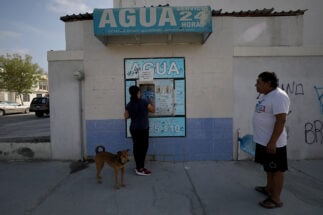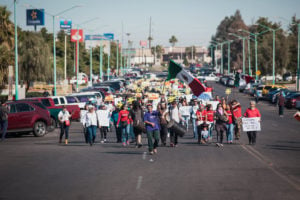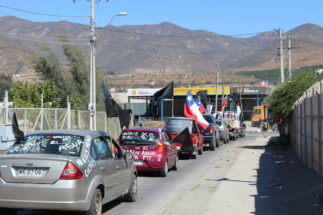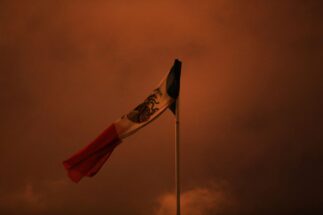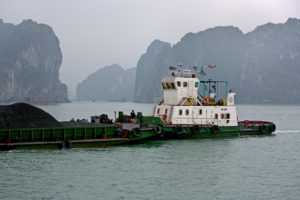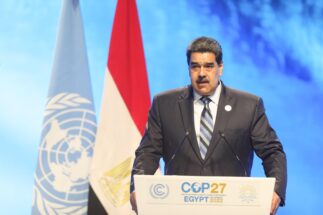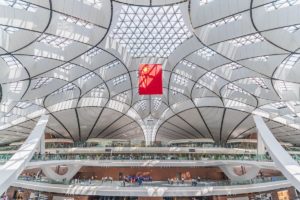Plastic bottles and packets float along the muddy waters of the Ramos, a river which supplies the municipality of Allende, in northern Mexico’s Nuevo León state.
Maribel and Norma García, Flor Rocha, María Luisa Reyes and María Adriana Rodríguez can all remember when the water used to be abundant, transparent and clean. Now, says Flor, it looks like atole – a thick, slightly milky corn-based drink.
“As time passes there is less and less water,” says Maribel, a native of La Palangana, a small community adjacent to the river. “It has been diverted to other lands.”
Residents of the communities surrounding the stream have for years complained that the diversion of water to properties upriver has decreased its flow.
Protests escalated in mid-July, when residents demonstrated against the use of pipelines by SADM, the water utility company of Monterrey, to divert as much as 500 litres of water per second towards the city.

In the early hours of 16 July, pipes were set on fire, halting government plans to supply the state capital, which has been suffering water shortages since the start of the year due to a severe drought.
It is as yet unclear who exactly set fire to the pipelines in Allende – “No one really knows,” says Norma García – but the event looks to have marked the beginning of a new fight for the people of La Palangana: to defend the Ramos River in a war on water, in a territory where drought is disproportionately affecting low-income communities.
Drought and the city
On 2 February, the government of Nuevo León declared an emergency in the state due to drought. Two of the three dams that supply the metropolitan area of Monterrey – Cerro Prieto and La Boca – had recorded historically low levels. At the end of March, La Boca was at 13% of its capacity, while Cerro Prieto only reached 7%, according to data from the National Water Commission (Conagua).
In mid-July, Cerro Prieto effectively ran dry, dropping to less than 1% of its capacity, thus failing to supply water to the metropolitan area for the first time since the dam was inaugurated in 1984.

Partly contributing to the dry conditions in northern Mexico is La Niña, the climatic phenomenon that intensifies winds and the cooling of the equatorial Pacific, causing floods in some regions and droughts in others. Unusually, this weather pattern has persisted since 2020, now entering into a third year. According to Mexico’s National Meteorological Service, it is expected that La Niña will remain until February 2023.
For the people of northern Mexico, climate change and its intensifying impacts are adding to the difficulties brought about by La Niña. Together, they are giving rise to a critical situation.
In García, one of the most affected municipalities in Nuevo León, some families have spent two to three days without home water supply; others have gone up to six months, and must buy their own water or access community tanks.
Following rains in September and October, SADM announced that the water service in the Monterrey metropolitan area was now being maintained 24 hours a day, with the exception of the municipality of García, which “has a structural problem in the supply network”. Users, however, have since reported on social networks that intermittent cuts in supply continue in the municipalities of Santa Catarina and Apodaca, on the edges of the metropolitan area.
Antonio Hernández, an activist and biologist from the Autonomous University of Nuevo León, explains that the established water distribution networks are no longer sufficient to supply neighbourhoods on the outskirts of Monterrey such as these.

“There is a metropolitan ring that distributes the water and from this it is sent to tanks that distribute it to homes,” says Hernández. “Part of the issue is that there aren’t enough tanks, and the ones that do exist are either practically empty or at very low levels. That is why the water does not reach the peripheral areas.”
With more than 5 million inhabitants in its metropolitan area, semi-arid Monterrey has seen exponential growth in recent years. This has led to an extraordinary demand for water for agricultural, industrial, commercial and domestic uses, generating stress on natural resources. Approximately 70% of the state’s water goes to the agricultural sector of Nuevo León, explains Hernández.
There aren’t enough tanks, and the ones that do exist are practically empty or at very low levels. That is why the water does not reach the peripheral areas
Rosario Álvarez, director for Mexico’s northeast at the environmental organisation Pronatura, says that urban planning in this time has almost been non-existent: “Why do you build so many houses so far from wells and water sources if you can’t adequately supply them with a resource that is basic to life?”
In addition to the pressures of the drought, Hernández and Álvarez point to poor water management and lack of infrastructure. In mid-June, for example, a two-metre crack in the El Cuchillo dam, to the east of Monterrey, affected six municipalities for several days. Many pipes have also not withstood the changes in pressure in the distribution network, causing leaks and wasting vast quantities of water.
Rationing and discontent
In March, the government of Nuevo León announced the Agua para Todos plan, a strategy of staggered supply cuts by municipalities. While citizens were advised to take short showers, industrial and agricultural users that draw from underground aquifers were only asked to voluntarily cede part of their concessions.
This measure caused social unrest, with roadblocks laid in protest and neighbourhood disputes becoming a feature of everyday life.
“The water trucks don’t come as much anymore because the violence was growing,” explains Francisco Flores Baez, a resident of Valle de San Blas, in the municipality of García. “People were fighting, piling up and pushing in to get water. It was a mess.”
For Flores and his wife Felicia, parents of two girls aged 9 and 13, expenses have increased as they have been forced to buy bottled water.
“We had diarrhoea and stomach pains and that’s why we started buying bottled water, but water also began to be scarce here in the stores,” Flores recalls. For more than three months, his local corner store limited sales to two 10 litres bottles per family per day to avoid panic buying.

Flores works in a luxury restaurant in San Pedro Garza García, the richest municipality in the country, where he has not seen people struggle like in García.
“There is always water there,” says Flores. “Besides, they have their cisterns and storage tanks.”
Water and inequality
Surrounded by juniper trees, Maribel, Norma, Flor Estela, María Luisa and María Adriana observe the muddy river. In addition to the poor quality of the water, the women are concerned that the river will dry up like the acequia, the traditional irrigation canals that carry water to fields – or used to, at least.
“We want our children, grandchildren, great-grandchildren to continue enjoying where they grew up,” says María Luisa. “The great-grandchildren are going to say: well, it used to be a river here. Just as we now say: before it was a very beautiful acequia.”
While in Monterrey the focus is on the dams, in La Palangana there is also a focus on conserving the ecosystem and biodiversity of the Ramos River. Álvarez emphasises that in addition to the dams, streams are also drying up, affecting a significant number of species.
“Nuevo León is much more than just the Monterrey metropolitan area, and it is much more than the individuals who drink the water,” Álvarez adds. “There is a very important amount of biodiversity that is having a very hard time with the drought.”
The women of La Palangana remember when fish species such as snooks, mojarras, Matalote conchos and many others used to swim in the river, but have now disappeared. The juniper trees, too, are drying up. For the river’s life, for the community’s people and for future generations, they have come together to defend the river, until after the drought ends.
